👇 CELEBRATE CLOUD SECURITY DAY 👇
00
HOURS
00
MINUTES
00
SECONDS

Certificate in International Logistics Management provides comprehensive training on managing the movement of goods and materials across international borders efficiently and effectively. The program covers topics such as international trade regulations, customs procedures, freight forwarding, supply chain management, and risk management. Skills covered include knowledge of import and export documentation, understanding of Incoterms, proficiency in using logistics software and tools, and ability to optimize logistics processes for cost savings and timely delivery. Prerequisites typically include a background in business or logistics, familiarity with international trade concepts, and basic computer literacy.
Why is International Logistics Management important?
Who should take the International Logistics Management Exam?
International Logistics Management Certification Course Outline
I. Introduction to International Logistics Management
II. International Trade Regulations and Compliance
III. Freight Forwarding and Transportation
IV. Supply Chain Management
V. Logistics Technology and Tools
VI. Incoterms and Trade Terms
VII. Customs Brokerage and Clearance
VIII. Risk Management and Insurance
Credentials that reinforce your career growth and employability.
Start learning immediately with digital materials, no delays.
Practice until you're fully confident, at no additional charge.
Study anytime, anywhere, on laptop, tablet, or smartphone.
Courses and practice exams developed by qualified professionals.
Support available round the clock whenever you need help.
Easy-to-follow content with practice exams and assessments.
Join a global community of professionals advancing their skills.
(Based on 32 reviews)